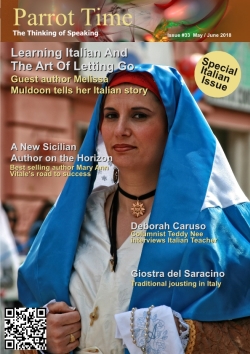
|
At a conference late last year I disagreed with a well-known linguist (Lourdes Ortega) about the way a presenter recorded the bilingual status of their respondents. Following a questionnaire they had filled in, the presenter had classed many of them as monolingual despite the fact that they could speak more than one language. Ortega highlighted the obvious contradiction. It was with my heart in my mouth, as a very junior researcher, that I spoke up, arguing that the respondents had to be classified as monolingual if that was what they identified as. Ortega kindly responded that for the purpose of research, measurable criteria had to be considered more reliable than reported behaviour. In other words, if these participants had a measurable level of proficiency in a second language, they were bilingual. Ortega was entirely correct of course. It is well documented in linguistics as well as in other fields that between what people say they do and what they actually do, there can be a world of difference. This exchange with a personal hero of mine about bilingualism made me question what I actually know about it beyond my personal philosophical perspective of it. Language measurements and social factors  Language can be observed or experienced in two ways. On one hand we can measure proficiency, accuracy, fluency, even accents can be measured through detailed phonetic analyses. Measuring language implies at some level that a standard exists, perhaps superior to its variations. On the other hand, languages are intrinsically embedded in a person's sense of identity – cultural, gender, age, national, any facet of your identity is expressed at least partially through your idiolect (an idiolect is the unique way a person uses a language which is shared by all native speakers of the same language). These measurements and factors can remain fairly abstract if they remain in the confines of a research journal. They are, however, meant to be representative of what happens in real situations. Here is an anecdote that might explain what I mean. Melbourne is a wonderfully diverse city in which every other person's English is not a mother tongue. Yet, for many of these people, English has become for all intent and purposes their first language, the language they use every day in most situations. An odd feeling of discomfort sets in when using their mother tongues with other native speakers. It was certainly my experience a few years after I left my native region of Switzerland. I had returned for a holiday and was having a drink with a friend of mine. During our conversation, he said to me "Tu parles comme un trouduc." (You talk like an arsehole) He was referring to my inability to have kept up to date with regional linguistic idiosyncrasies, making me sound like I had rejected my country of origin. In just 5 years of absence, my accent had changed enough for him to feel like we no longer shared the same cultural background. This is not just because I had just spent 5 years teaching French as a second language, having to tone down my accent and vernacular. It was also because in truth, I did not have any intention of returning to live in Switzerland. I had entirely adopted my new country of residence and as a consequence, I had become an English speaker. My friend, as a consequence, identified some of my idiolectal features and assessed them as clashing with what he knew of my sociocultural profile. When I started to read up on bilingualism, I began to realise that while my experience was similar to many other 'expats', the range of ways in which bilingualism emerges is quite vast. Here are just some of the types of bilingualism frequently encountered research literature and how they came about. Passive vs active; simultaneous vs sequential; dominant versus balanced; additive vs subtractive  Since the 1970s a number of questions were raised about assumptions pertaining to bilingualism. Some of these assumptions included the belief that children raised multilingual were linguistically confused. The proof was that most kids brought up in multilingual environments tend to code-switch, ie to draw from more than one languages in the same sentence. Salvatore's codeswitching in "The name of the Rose" may have been inspired by the codeswitching fears. In order to explore assumptions like the above example, researchers categorised types of bilingualism based on language competence, age of language acquisition, learning context and interactional use of the linguistic resources. The four pairs mentioned in this section's title each highlight some aspect of bilingualism. There is some overlap and more than one terminology often exists to describe the same concept, like receptive vs productive, which is all in all the same as passive vs active. Each pair can also describe fairly different situations, depending on what dimension of language one focuses on. For instance, a second generation Australian Chinese man could be actively bilingual in reading, but not in writing. Passive bilingualism is when a person is brought up speaking one language but understanding two (or more) whereas its opposite describes a person who my express themselves in more than one language. Both types of bilinguals are quite typical of kids who grow up with one parent speaking to them in a language other than the dominant one of their region. In the case of passive bilinguals, they understand most things that is being told in their second language but they do not use it. They often end up forgetting much of it when they are no longer exposed to the language. Passive bilinguals are also frequently found among second or third generation minority group members. The heritage language is gradually forgotten as subsequent generations integrate into the dominant linguistic group. Simultaneous bilingualism is characterised by the acquisition of two (or more) languages in parallel with their first language, as opposed to sequential bilingualism, which is when a person learned a second language at a later stage in their lives. Simultaneous bilinguals have better chances to reach high levels of fluency in their second language, but this is not always the case. Age has long been a focus in second language acquisition. The popular opinion is that the younger a person, the easier (and the better) they may learn the second language. The famous Critical Age Hypothesis, stating that a language becomes much more difficult to learn after the age of 12 or 13, supports this opinion. However, there are many examples contradicting this hypothesis, leading to question second language pedagogy.  Balanced bilingualism is defined by a person whose languages are equal in every way, whereas a dominant bilingual has a higher level of competency in one of their languages. Balanced bilinguals are considered somewhat of a myth by most researchers in language acquisition, although there are people who claim it. If they do exist, they are rare, and extremely difficult to test objectively. Dominant bilingualism is therefore the norm. The reason is that the vast majority of people divide their daily activities like work, family, sports or religion in linguistic ways as well. They end up feeling very confident buying their groceries in one language while have a professional discussion in another. Additive bilingualism focuses on the process and development of language acquisition and describes the situation in which a second language is learned by a person, leaving their first language unaffected. This means that they are continually exposed to their first language and consequently do not forget it. Subtractive bilingualism, on the other hand is when a second language progressively replaces a person's first language. Many expats experience this. It's a difficulty to remember some words, the adoption of a foreign prosody (speech rhythm and musicality) or even the adoption of a foreign accent. For a couple of decades, only additive and substractive bilingualims were properly theorised, leading most second language acquisition experts to believe that additive bilingualism was some sort of ideal. However this conceptualisation was on the premise that a high level of second language competence is required. When the focus turned towards cross cultural communicative ability, languaging and translanguaging became a phenomenon that many recognised as more essential. Along with it came the understanding that speaking another language is all good, but that communication could only be successful if contextualised cross cultural understanding also took place. As most societies in the world are multilingual to begin with, however dominant one language may be, productive bilingualism describes more adequately what happens in real situations. Go to a Moroccan market, walk around Paris, eat at your local Italian restaurant, and you will see productive bilingualism in action. Complete control of all linguistic resources is not required. It would most likely be counterproductive if a language was chosen by one of the speakers in the conversations to the exclusion of the others. A second point to make in relation to these pairs is that mostly they are not, in fact, opposites. It would be more accurate to say that they are two sides of a continuum. |
| On Being Bilingual | |||
| Writer: | Olivier Elzingre | ||
| Images: | |||
| |||
All images are Copyright - CC BY-SA (Creative Commons Share Alike) by their respective owners, except for Petey, which is Public Domain (PD) or unless otherwise noted.
comments powered by Disqus
















